Ahsoka Case Study
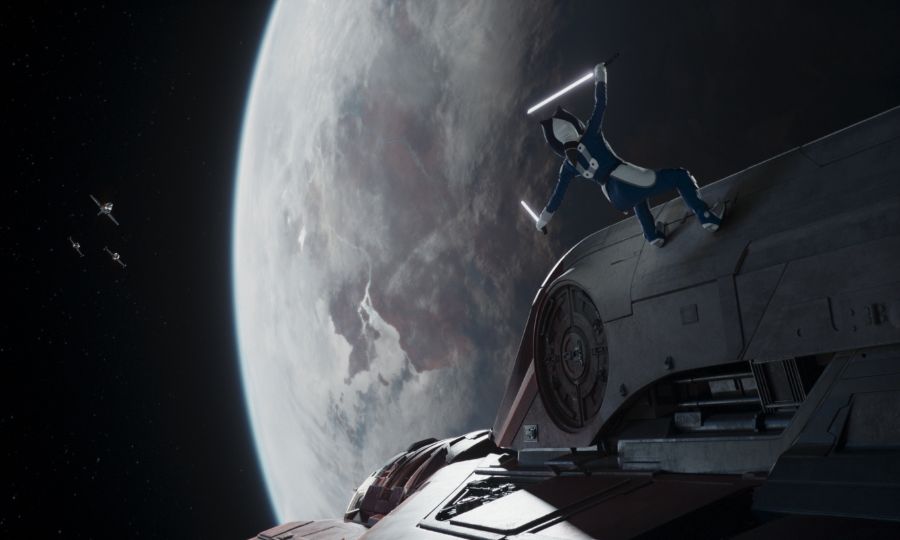
Case Study
Ahsoka debuted on Disney+ in 2023 as the fifth live-action Star Wars series. Following the beloved character Ahsoka Tano's journey post Star Wars: Rebels, the series shows the Star Wars galaxy at its most dazzling yet – with Image Engine contributing to 282 shots across four episodes.
View portfolio page Watch our breakdown reelDebuting on Disney+ in 2023, Ahsoka is the fifth live-action Star Wars series to appear on the platform, following The Mandalorian, The Book of Boba Fett, Andor, and Obi-Wan Kenobi. A spin-off from the critically acclaimed Star Wars: The Clone Wars and Star Wars: Rebels animated series, this live-action production embarks on a new journey with the fan-favourite character, Ahsoka Tano, a former Jedi Padawan of Anakin Skywalker, who walked away from the order after being falsely accused of a crime.
Set after the events of Star Wars: Rebels, the series follows Ahsoka Tano as she navigates a galaxy still mired in chaos following the fall of the Galactic Empire. Living in the shadows and armed with her signature white lightsabers, Ahsoka continues her relentless pursuit of justice and peace while facing numerous threats along her path.
Fans have long celebrated Ahsoka’s animated adventures for their visually stunning portrayal of the Star Wars universe. And the live-action Ahsoka, with its expansive, exotic alien landscapes and spectacular space battles, is no different. Image Engine created 282 of the visual effects shots that contributed to this compelling universe, following on from the studio’s ongoing adventures with The Mandalorian and The Book of Boba Fett.
The company’s state-of-the-art work on the series across four episodes ensured that Ahsoka’s battles, both terrestrial and celestial, retained all the visually stunning splendour fans have come to expect of the character.
Blast off
Some of Image Engine’s most comprehensive work on Ahsoka involved the most beloved and exhilarating of Star Wars set pieces: the space-based dogfight. Image Engine significantly contributed to a stellar sequence in episode three, where Ahsoka, alongside her ally Sabine, finds herself embroiled in a fierce confrontation amidst the expansive vastness of the cosmos. Piloting a T-6 shuttle, the pair fend off snub-fighters in a duel that resembles a high-stakes ballet set against the coruscating backdrop of the star field. In the sequence’s climax, Ahsoka daringly exits her spacecraft to take a bold stand on its wing. With her lightsaber ignited, she readies herself for a Togruta-versus-snub-fighter showdown. It’s an unforgettable high point of the episode.

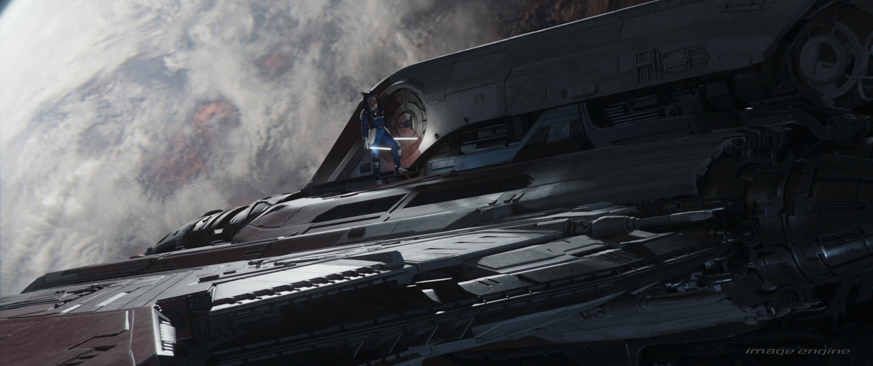
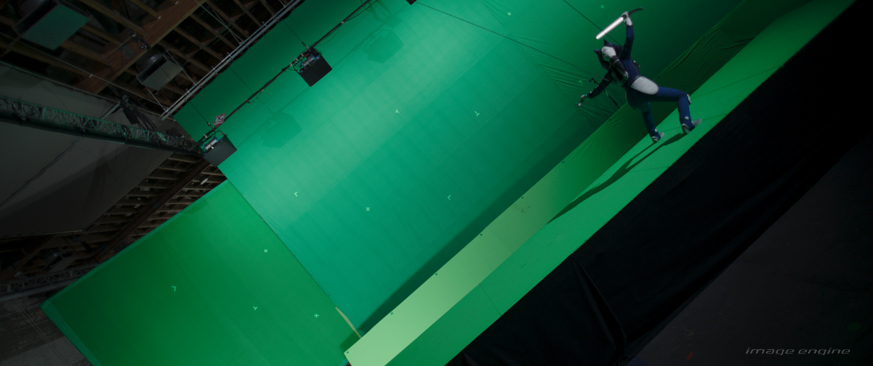
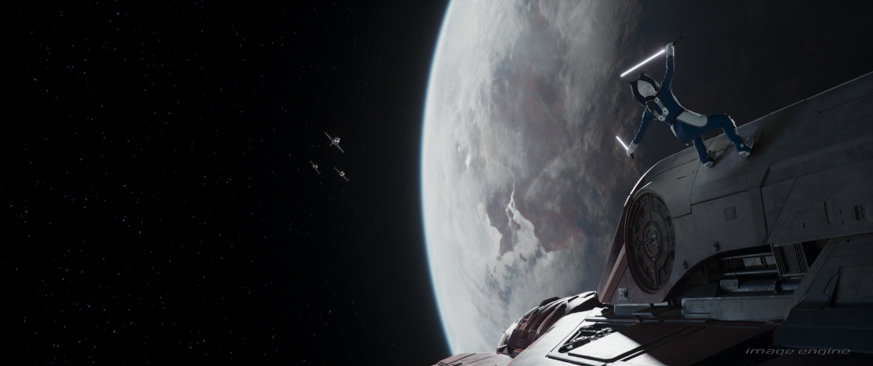
And even this isn’t the sole highlight of Image Engine’s expertise. Audiences also encounter the menacing Sith space station, The Eye of Sion; an asset ingested and prepared for screen by the Image Engine team.
From the initial pre-visualization of the dogfight to the final touches of lighting and rendering, Image Engine poured its creativity and technical expertise into these sequences. Below, we unravel the processes that transformed these visionary concepts into cinematic reality.
Pre-visualizing a dogfight
Step one involved Image Engine creating the pre-visualization choreography that dictated the space sequence’s staging and overall rhythm. Showrunner Dave Filoni provided the scene’s groundwork, sketching storyboards and supplying panels to Image Engine. The studio then took the reins, steering the pre-vis process and elaborating on ideas while collaborating closely with the production.
“With a great briefing kick-off and boards from Dave Filoni, we were well equipped with a blueprint on how to deliver on his vision for the sequence,” says Andrew Parnell, Animation Supervisor. “We approached it entirely with the intent to tell the story the director envisioned as clearly and efficiently as possible.
“To start, we looked closely at the Original Trilogy dog fights and the ‘making of’ docs, as one of the things we needed to consider was achieving the feeling of the Original Trilogy’s dog fights, which were shot with motion-controlled cameras on a sound stage, while keeping under consideration the full-CG nature of the shots. We also watched other films containing dog fights and WWII gunner cam footage as a reference. After that, we started turning Dave’s storyboards into shots.”
As the pre-vis moved along, we worked closely with the production, tweaking and adjusting the work as needed. “The team worked closely with the production to achieve the look and feel of a Star Wars space battle,” says Ryan Woodward, CG Supervisor. “In the early stages, we used basic models, textures, and lighting to present ideas for how we envisioned the sequences playing out. The pre-vis stage was a good time to iron out upcoming technical challenges for other departments.”
“The production was quite open to us driving the sequence, offering suggestions, and giving options. In many cases, we would provide multiple alternative takes on animation to flesh out ideas,” adds Robin Hackl, VFX Supervisor. “Designing the dog fight choreography was a case of having freedom but working very collaboratively with Dave Filoni directly.”
Making space and building planets
Ahsoka’s dramatic dogfight unfolds against a vast and expansive star field. Image Engine plunged into creating this cosmic backdrop early in the show’s development to establish and refine its approach to both the stars and closer-by planets.
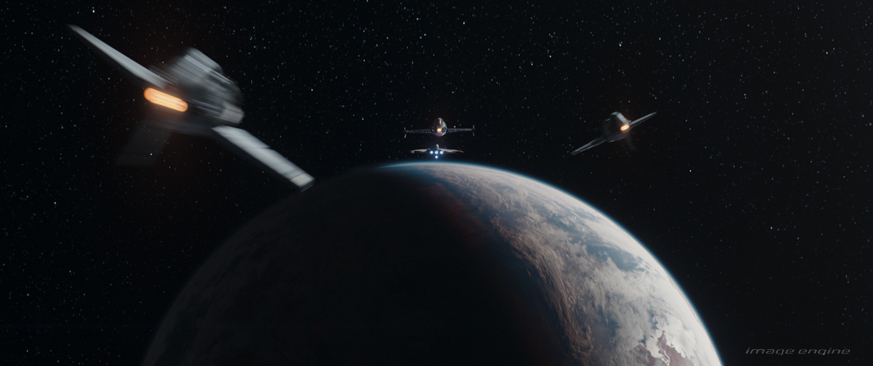
“Because this is a Star Wars story, there is a particular look required of the space environments and ships to help marry the shots to other Star Wars shows and other vendors’ work,” says Ryan. “As such, we wanted to keep the production team in the loop regarding the look development and always have their eyes on the work as it developed. We always aimed to present our animation renders in a way that would represent the final shot as closely as possible, trying different lighting scenarios and adding in looks for the various ships, starting with temp looks and eventually final looks. The final lighting did vary from the animation renders, but working in this way was still valuable in aligning with the production team and achieving the right look for the star field sooner rather than later. It was a very collaborative process between animation and compositing to get this working, with a lot of back and forth between the production and us to dial into the desired result.”
The space sequence features two planets in the background, Seatos and Peridia. Seatos takes center stage in this interstellar tableau, seen in both wide-angled, distant shots and closer views of its upper atmosphere. Image Engine brought Seatos to life, drawing inspiration from concept art to shape its aesthetics.
“After testing a few different options, we chose to use Terragen to generate the planet,” says Ryan. “The plan was for the mid-to-far shots to have the planet positioned on a card using the high-resolution (16k) images generated from Terragen. We would then include this output in animation renders early to give the client a clear look at the planet’s development as it progressed. We split the renders from Terragen into multiple control AOVs and published them back into the Image Engine pipeline to give the compositing team the flexibility they needed to achieve the final result.
“The close-up shots of Seatos required further testing and development,” he adds. “They ended up being a combination of images generated from Terragen and then a projection system from DMP to achieve the layers of atmos, cloud, and planet surface.”
Robin Hackl also explored an alternate method for the close-up shots of Seatos using Blender. He and his team incorporated high-resolution cloud maps into the final Seatos renders to create a realistic depiction of the planet’s cloud patterns.

“We ended up with multiple different renders for Seatos to accommodate the look required for each sequence, some with the planet more shadowed and others more exposed to the sun’s direction and a few additional fill passes,” says Hackl. “For the planet Peridea, we used the same approach; however, this was only for one shot in the sequence. Using the knowledge we gained from Seatos, Peridea sailed through the pipeline pretty quickly.”
When compositing the sequence, Francisco Palomares, Compositing Supervisor, and his team used a participle system in Nuke to generate the star field. “We noticed early in the game that the variations in focal length were creating big differences in the size of the stars,” explains Francisco. “So, to make the sequence work and ensure we worked consistently with other departments, we baked the particles into several 20k latlongs and published them for different shots depending on their focal length. The Layout, Animation, Lighting, and Comp departments used these same latlongs, ensuring consistency.
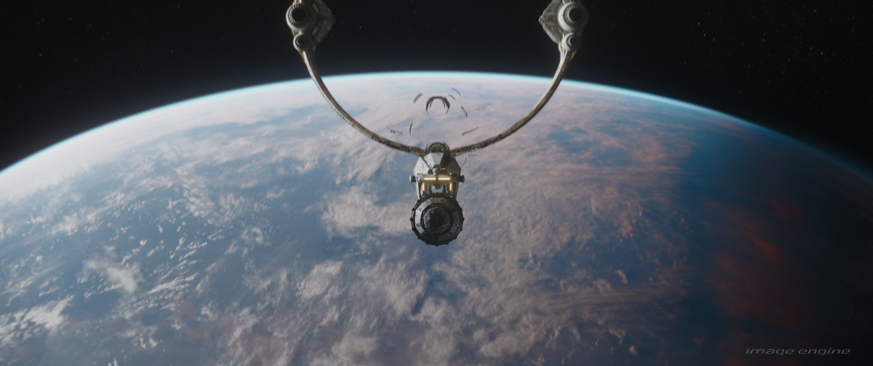
“In some of these shots, we had to add lens flares linked to a ‘sun’ or bright light source not visible on screen,” continues Francisco. “Sebastian Schuett, our Compositing Lead, along with the Pipe Team, put together a workflow to publish the position of those suns in 3D space and feed our lens flares within Nuke with a few simple clicks. This process added to the realism of the flares – and therefore the whole sequence – as they worked nicely in relation to the camera movement.”
Creating movement in empty space
One core challenge Image Engine faced in the episode three dogfight sequence centred around creating a sense of movement and speed.
“If you watch another Star Wars space flight beat, it has something to ground the action – the X-Wing flying over the Death Star or the Millenium Falcon over Jakku. It gives you a sense of movement and speed,” says Robin. “In our Ahsoka sequence, we were flying through space with only stars in the background and nothing to ground audiences or show how fast these fighters were moving. To overcome this, we did many things like cheating stars and animating them independently of the camera and using lighting direction inside the cockpit to insinuate movement. Without those things, you’d just have ships floating in space. We needed the sequence to feel fast and dynamic.”
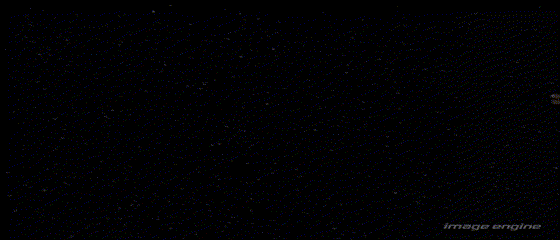
“We discussed the challenges that can come into play when working on a space environment very early on in production,” adds Ryan. “One of the issues was working at distances far away from the scene origin, which can cause many rounding errors and play havoc on renders. Animation needed to keep a close eye on this throughout the process, keeping the elements in the scene as close to the origin as possible to ensure viewers stayed immersed in the scene.”
The Eye of Sion
The Eye of Sion is a formidable Sith space station that bristles with cannons and dominates the screen, which features prominently in Image Engine’s work on the second episode of Ahsoka. This intricate asset, brought to life by Image Engine in collaboration with ILM, was constructed in two distinct forms, each crafted with careful attention to detail.
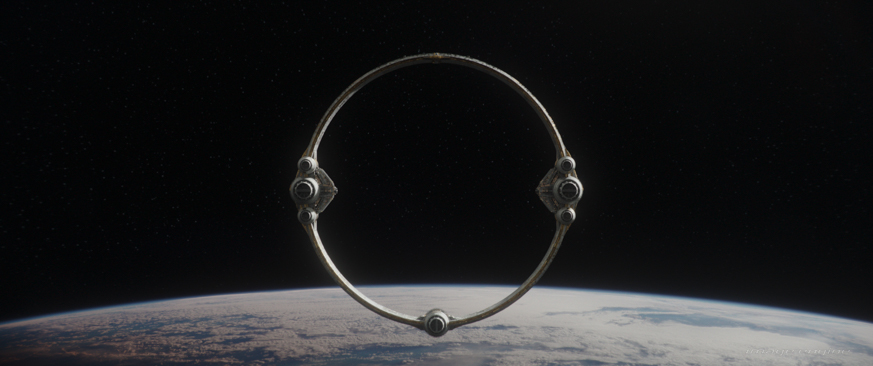
“The Eye of Sion was an asset created by ILM which we ingested into the Image Engine pipeline. We received the file, then did a lot of work on top of it to make it shine in our shots,” says Cara Davies, VFX Producer. “For example, using the asset we ingested from ILM, we created a partly dismantled version of the Eye of Sion, which was used in several shots, while the others featured the space stations finished, complete version.”
“For the pre-vis portion of the show, we populated our pre-vis scenes with a low-poly proxy version of the space station. Once we received the official asset, we swapped out our proxy Eye of Sion with the real deal and repositioned it to compensate for the difference in scale,” says Andrew. “Following that, we worked with the production to dial in the scale and position of the space station’s canons. We sent the production multiple variation wedges so they could choose the cannon size/position they thought worked best.”
The Eye of Sion is a colossal spacecraft, and its size presented unique challenges for the team. Ryan quickly recognized the need for clever thinking to integrate this mammoth asset smoothly into the Image Engine pipeline. “The scale of the Eye of Scion meant the animation rig was extremely data-heavy,” says Ryan. “We solved this by including only the canons in the animation rig, as they were the main moving element the team needed to focus on. Doing so kept the rig manageable for the animation team. Thanks to these optimizations, the asset ran through our pipeline with few issues.”


For the detailed close-up shots of The Eye of Sion, Image Engine made adjustments tailored to specific camera positions within each shot. “We tasked one of our concept artists to design an up-rezzed version of the areas closest to the camera, then made sure we received sign-off on these designs from the production,” says Ryan. “Once production approved the assets, we patched the existing model to the approved concept, which got us over the finish line.”
For Francisco and his compositing team, their primary objective with The Eye of Sion was to amplify its monumental presence, ensuring the spacecraft always felt visually dominant in its shots while maintaining a consistent and believable relationship with other elements on the screen. “Lens effects such as defocus, chromatic aberration, glows, and such played an important role in making the shots look as realistic as possible,” says Francisco.
Lights, cannons, action
The use of FX was paramount in the execution of Ahsoka’s dogfight sequence. Image Engine designed effects such as blasters, flak explosions, trailing smoke, sparks, and the T6’s protective shield reacting to blaster hits to heighten the sense of danger and destruction.
“Image Engine has plenty of experience working with blasters in the Star Wars universe. However, as the blasters here were firing from the Eye of Sion and the ships’ cannons, which are much larger than traditional blasters and travel greater distances, we overhauled the blaster system we’d used in other Star Wars projects, ensuring it worked efficiently at this scale,” explains Ryan. “This came with challenges with the rig, animation, lighting, and comp to achieve the desired blaster results and their interactive contribution on ships and FX elements.”
On previous Star Wars shows, Image Engine kept its blaster rigs stationary. On Ahsoka, this was not feasible, as the ships in the dogfight sequence move at such high speeds and across great distances. “We experimented and landed upon a method that would allow us to parent the blasters to the ships without introducing motion blur issues,” says Andrew. “We also had to think around challenges related to the Eye of Sion, which, in some shots, sits far in the background and fires toward the camera. Getting the bolts that appear further in the distance to read easily without having the scale look inaccurate was a challenge – but the team pulled it off!”
For Francisco and the compositing team, the focus of this sequence was ensuring each shot told the story Dave Filoni wanted to convey. “We received some anamorphic plates for Sabine, Ahsoka, and Shin, which we had to combine with full CG shots in the cut,” explains Francisco. “As the shots had to work in context, we built a framework for how the shots had to look, with the right amount of pollution, defocus, and all the subtle qualities visible in the filmed images. We made sure each shot had consistency in look and feel.”
Wing walking
Image Engine’s work on the dogfight sequence ends with Ahsoka exiting the T-6 spacecraft, taking a stand on its wing, and skillfully demolishing a snub-fighter with her lightsaber – all in the middle of space. This sequence relied on a full CG digi-double, which allowed for the fluid portrayal of Ahsoka’s movements in the zero-gravity environment.
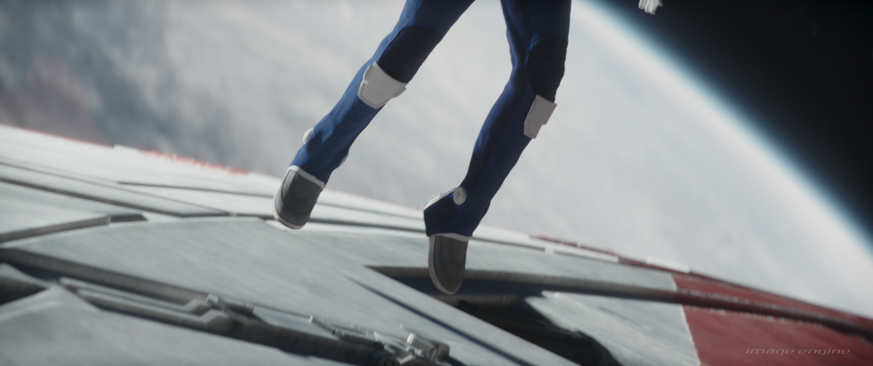
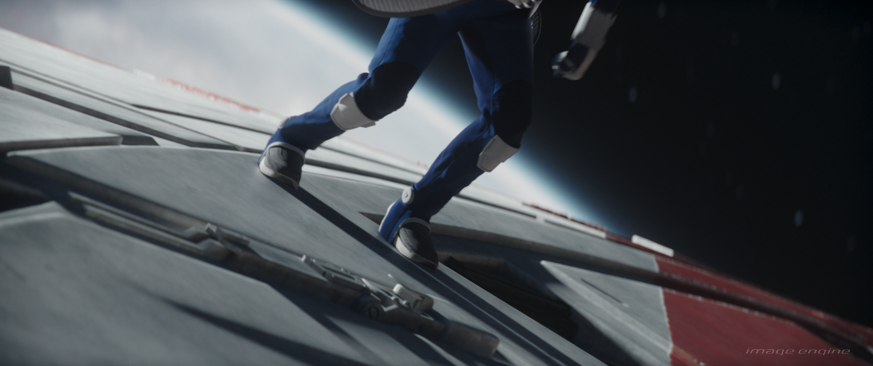
“Initially, the production shot the actor performing the stunt practically on a green screen stage,” says Robin. “We used some of this plate footage wholesale, but as the sequence progressed, we also pivoted in certain cases and used a full digital Ahsoka to control the animation and tie the shot together. This approach meant taking the green screen plate and roughly assembling the digi-double choreography during pre-vis, then giving the production an edit to ensure they were happy with our direction. It was a collaborative process with some back and forth to ensure we had a sequence that worked. Some iterating and massaging were required to ensure this big beat in the sequence delivered what Dave Filoni wanted from the sequence – which was wowing the audience at home!”
From an animation department standpoint, Andrew and the team knew the sequence would be challenging, given the combination of shots incorporating both live-action plate elements and zero-gravity full-CG character shots. “We faced a few tricky propositions,” he says. “For example, we would take some shots that used plate elements of the on-set actors and reposition the element to the desired location. Upon doing so, the CG version of the character (used for shadow casting and interactive lighting) would no longer line up accurately with the plate element. As such, we would need to adjust the CG character’s performance to bring it closer to what was in the plate. This process would often be tricky due to a difference of perspective! Nevertheless, I’m super proud and excited about how the space sequence turned out. The animation team worked hard and was clearly dedicated to delivering quality work.
“To work on something as iconic as a Star Wars dog fight and be part of that process from pre-vis to final animation was something special.”
From the extraterrestrial to the terrestrial
In the seventh episode of Ahsoka, viewers encounter a new environment on a distant planet, where an explosive battle takes place between our heroes and the Empire. Viewers witness a thrilling chase sequence, where the force-sensitive freedom fighter Ezra Bridger seeks to escape a pursuing Empire alongside the Notis – a small, turtle-esque species who travel in small, hovel-like ships known as Noti pods. During the chase, one of these pods is blasted and falls to the planet surface, whereupon its companions circle around and land to protect it. The scene intensifies as Ezra and his companions engage their Empire adversaries in a whirlwind of combat and a display of formidable Jedi force powers.
The production initially filmed the sequence on a backlot, where round tables stood in for the Noti Pods, with the understanding that they would undergo digital replacement later. Image Engine was the studio tasked with replacing these placeholders and digitally recreating the surrounding environment, extending to the horizon line – effectively transforming the backlot into an immersive, alien world.
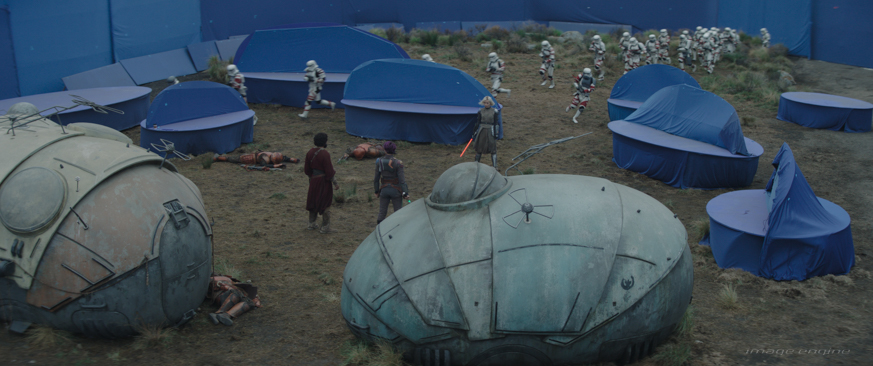
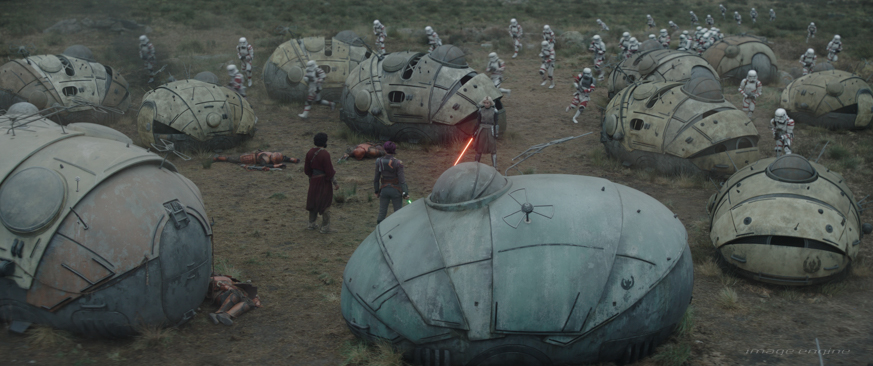
“From the beginning, we wanted this environment to be fully CG-built,” says Adrien Vallecilla, CG Supervisor. “The on-set environment was quite small and had a lot of blue screens. We knew that it would be easier to use a full CG environment in some shots rather than trying to blend the practical set with the CG elements. So, with the digital environment, if we needed to skip the plate and use a complete CG environment instead, that would be possible.”
To kick things off, Image Engine prioritized the more significant ‘hero shots’ early in production. The team dedicated their efforts to fully rendering these shots in CG until they achieved a level of realism so high that distinguishing between the plate footage and the CG elements became virtually impossible.
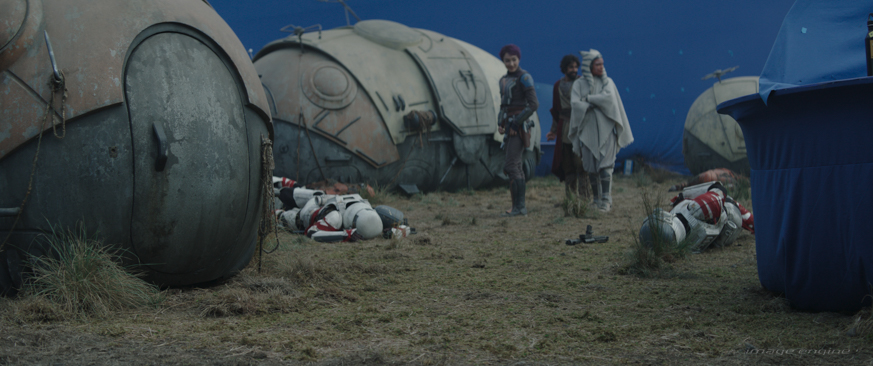
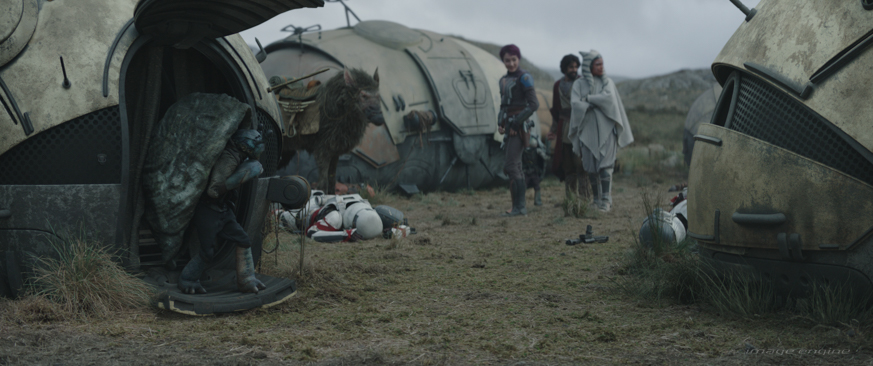
“The main environment, including the ground and mountains, consisted of scans of mountains taken in Scotland, provided by the production. On top of that, we scattered various plants and rocks,” says Adrien. “It was important for us to have two separate environments: the set coverage and the rest. Splitting things in this way allowed us to easily separate what would be plate and what would be CG extension. We rendered both parts of the environments in all the shots so that the comp team could choose whether to keep the CG ground or the set ground.”
A note on the Noti Pods
The Noti Pods are a cluster of 18 stationary ships embedded in the landscape, with the spaced between serving as the primary battleground for Ahsoka’s heroes against the Empire. During filming, three of these pods were physically built on-set, while the others were represented by blue screen proxies, or “dining tables,” as the production referred to them.
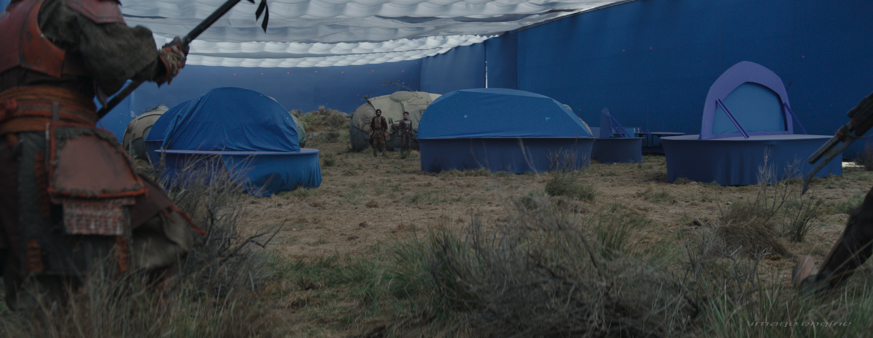
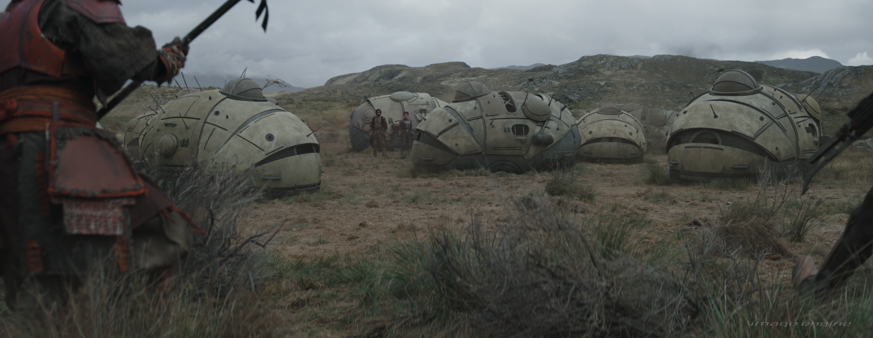
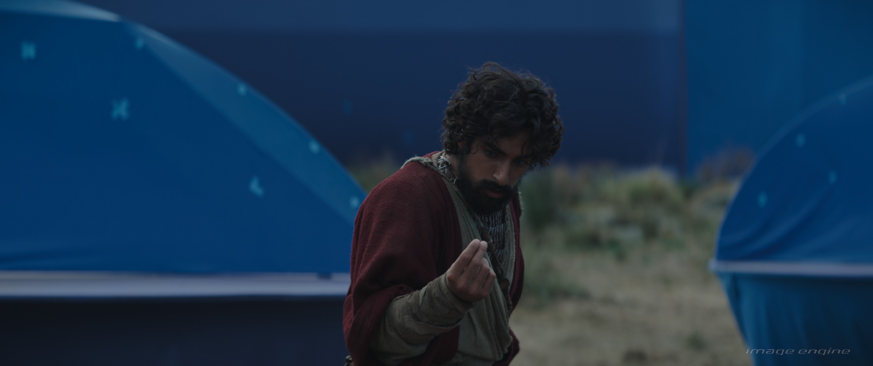

Image Engine’s objective was to establish a base layout and substitute all blue-screen Noti Pods with their CG counterparts. However, when the team started solving the plate cameras, they discovered a hurdle: the positions of the physically built Noti Pods altered from shot to shot. This inconsistency rendered Image Engine’s original layout unfeasible for reuse across all the shots, necessitating a more flexible and creative approach.
“We started with a very consistent baseline layout of the pods, and then we would subtly massage that on a per-shot basis to help us with the plates or if it was beneficial for us to move it,” says Robin. “Next, the Layout team offset the CG pods shot by shot so they properly covered the blue screen proxy pods in the plate.”
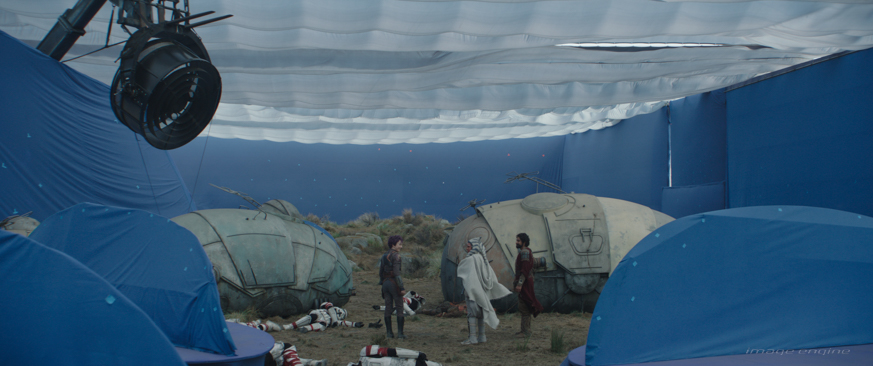
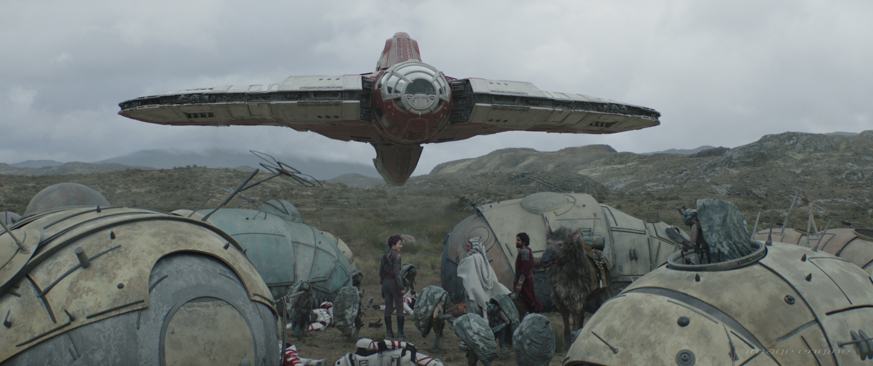
To establish a seamless integration between the CG-rendered Noti Pods and the real-world terrain in the footage, Adrien and his team designed a vegetation layout surrounding each pod. “The challenge was to seamlessly blend the plate ground with the Scotland scan environment, as the colours and locations were different,” says Adrien. “To do so, we created a custom scattering and colour in the set and a soft falloff to the outside environment, which was greener and more densely scattered. Doing this helped to break the contact point and seamlessly blend the Noti Pods with the plate.”
Image Engine also added CG vegetation around the Noti Pods and matched its animated movement with the vegetation in the plate footage, as Adrien explains. “Each plate had a different amount of wind, so the team’s goal was to match the set’s wind intensity. The FX team created wind simulations for each plant, and look-dev created a context variable for lighting to swap the static plants with wind FX plants. Based on the plate, the lighting team could then turn the wind animation on/off and control its speed.”
The team also embarked on a meticulous process to minimize discrepancies in the plate footage lighting (a common challenge in scenes filmed outdoors) to ensure visual continuity and authenticity. “Some plates had more directional light, while others were darker, and so on,” says Adrien. “To achieve consistency, the team neutralized and balanced the grade of each plate. The lighting team then overrode the key light to match each set lighting. This process was a lot of work but resulted in a more consistent look across the final sequence.”
The Notis and their pets
As for the alien Notis themselves, Image Engine based the creature designs on assets received from ILM. The task was multi-faceted: the studio needed to ingest these creature assets, accessorize them, and ensure they used a variety of the Noti assets to avoid repetitiveness. Next, Image Engine proceeded to rig and animate each Noti in a way consistent with their on-set, puppeteered counterparts.
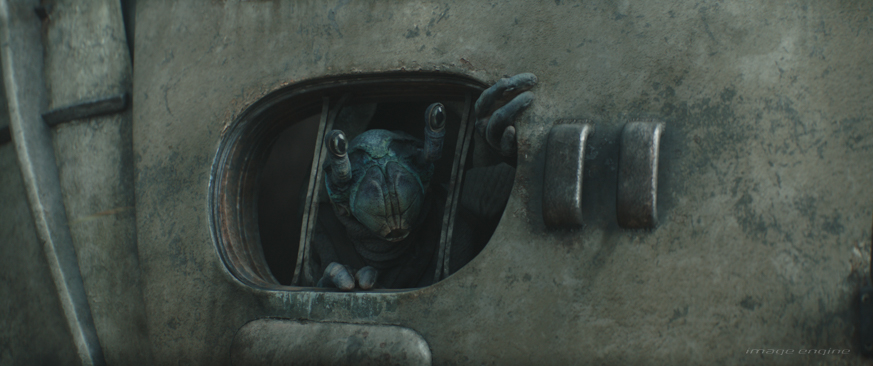
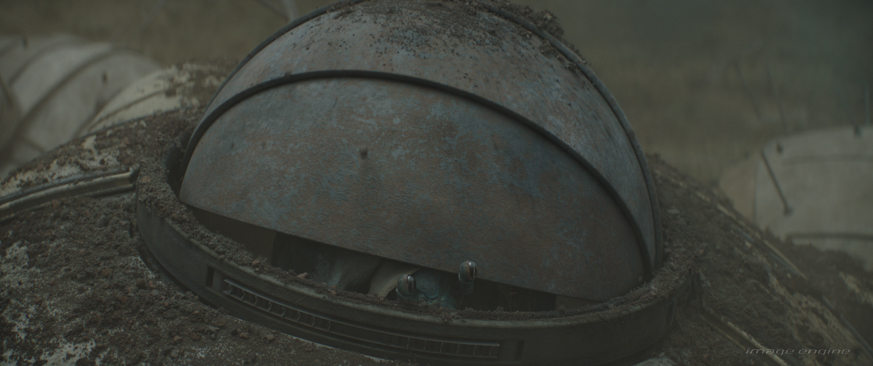
“During the shoot, the production used practical Notis as puppets,” says Adrien. “Since some shots involved puppets while others required our CG replacements, our animation team had to carefully observe the puppet movements and replicate them so as not to break audience immersion. Our team animated the Notis in a manner that appeared natural but remained constant with the practical actions performed by the puppeteers on set.”
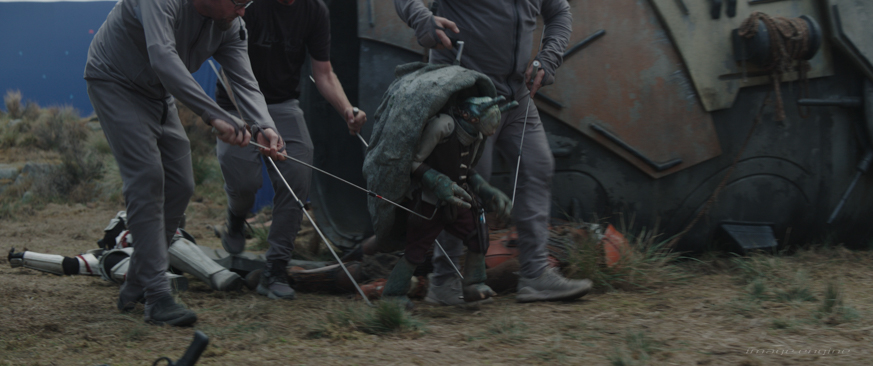
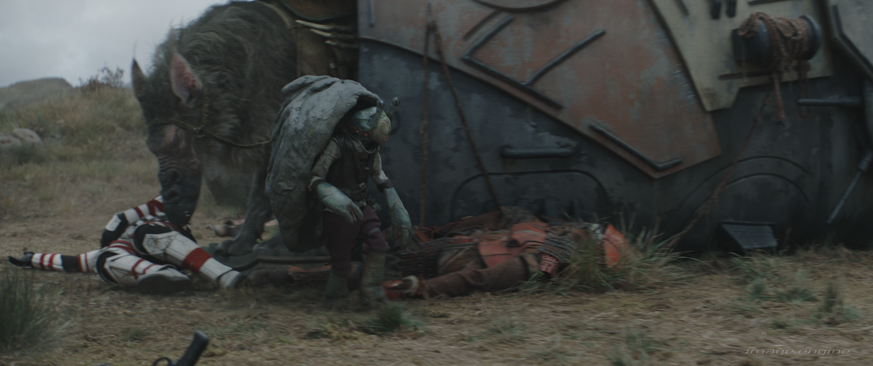
“The Notis were cute little characters,” adds Andrew. “I think animating them with the restricted motion of a puppet added to their charm!”
The Notis aren’t the only aliens present in the scene. At one point, audiences see two “Howlers,” large creatures that Adrien describes as “big space wolves that can be ridden like horses.” Again, these assets were ingested from the production. Image Engine’s objective was to incorporate them into its pipeline and animate them.
In some shots, the production used actual horses as practical Howler stand-ins. Image Engine replaced these on-set horses with CG Howlers, ensuring a smooth integration between the plate actor and the CG Howler. “We built CG Howlers that matched the proportions of the horses on the set. This was extremely useful for matchmove, as it allowed for a one-to-one match with the plate horses,” continues Adrien. “The animation team then used retargeting techniques to attach the Howler’s rig to the matchmove horse. This process allowed matchmove and animation to create a natural Howler animation that matched the movements of the set horse.”
In addition to the Howler, Image Engine created a saddle asset that matched the on-set saddle seen in the plate footage. “We rendered this asset separately to provide the compositing team with the flexibility to decide which parts of the plate saddle to keep and which to replace with the CG saddle,” says Adrien. “Matchmove provided us with digi-doubles to generate contact shadows and occlusion passes from these doubles onto the Howlers.”
After securing approval on the animation, Image Engine’s Character FX (CFX) team stepped in. The crew simulated the Howler’s fur to accurately replicate the wind effects observed on the set, adding a further layer of realism to the animated creature.
Bladesmiths
With the environment and its inhabitants successfully established, Image Engine’s subsequent challenge lay in enhancing the dramatic lightsaber battle that plays out against the backdrop they had crafted. In the sequence, the characters elegantly vanquish their Empire foes, leveraging the Force to their advantage. In a particularly striking moment, a character thwarts a lethal lightsaber strike using the power of her mind, the sheer intensity of the act causing the usually steady blade to quiver and distort.
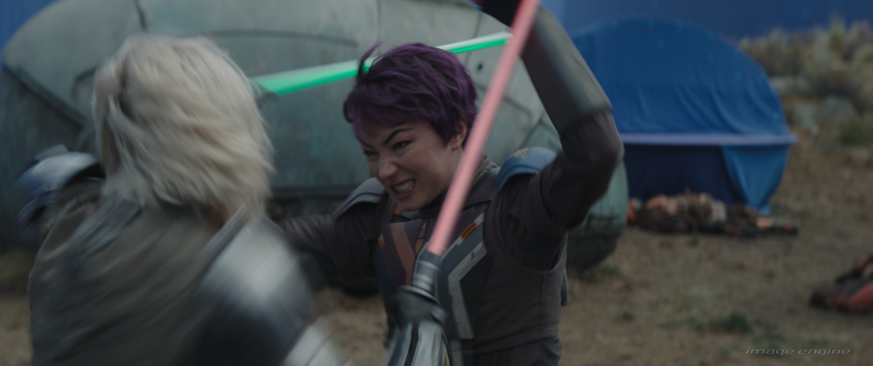
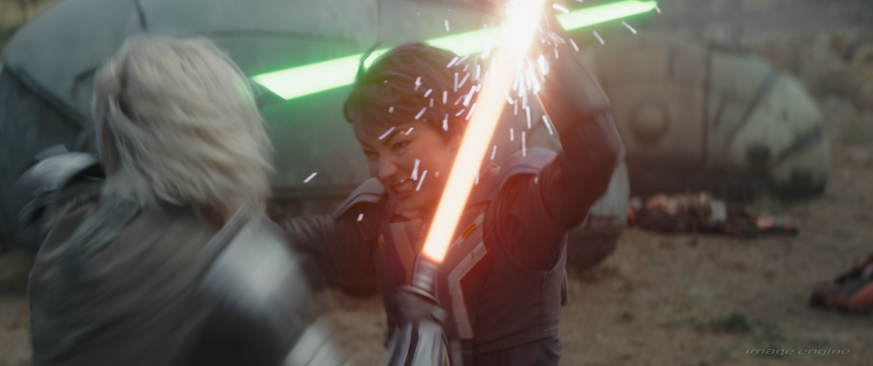
To create the lightsabers, Image Engine needed to build three different length variations to match the on-set practical lightsaber blades. “Some shots had shorter blades, while others had longer ones,” says Adrien. “Our matchmove team needed all the different blade lengths in the asset, so they could easily swap to the proper blade length and matchmove the plate. Once we extracted the plate blade, we exported it directly from match move to lighting.
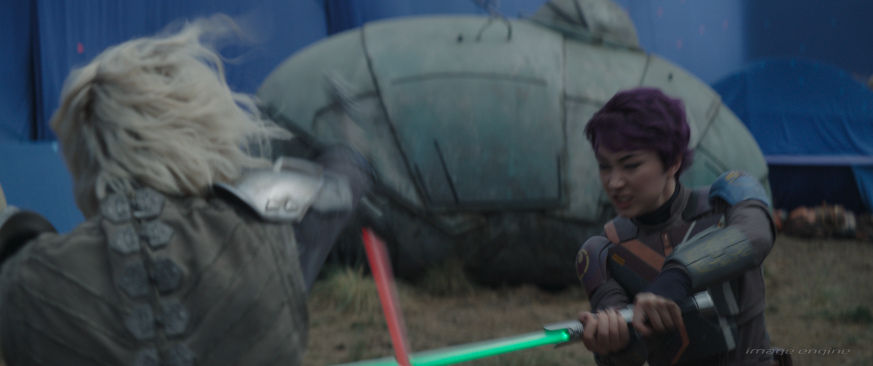
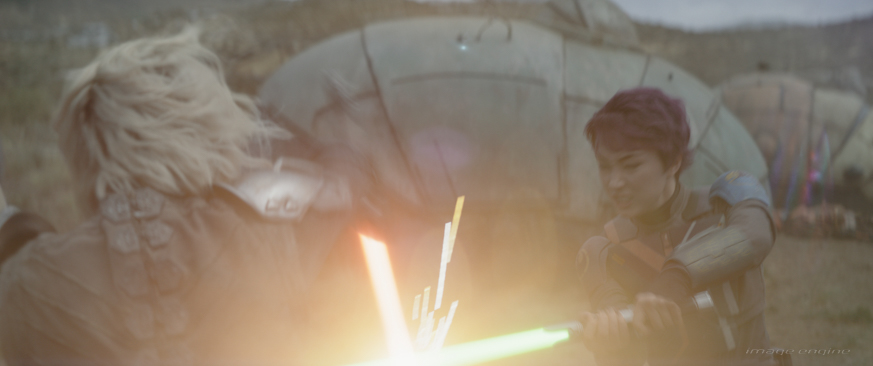
“To ensure precise curves in the motion blur movement, we needed to render the lightsabers with true lighting and export them with 12 MB sub-samples,” continues Adrien. “By default, lighting would render the longest blade, but if this blade intersected with the environment, they needed to swap it with a shorter one to compensate.
“Once we’d rendered the blade, the Comp team added the colour and glow effects.”


Working with focus
Image Engine’s work on Ahsoka was much like that on The Mandalorian and The Book of Boba Fett – complex and requiring contributions from multiple creative departments. Yet, the body of work was also distinct from the studio’s contributions to other Star Wars shows, as the 282 shots consisted of two well-defined, cohesive sequences – the dogfight and the lightsaber battle.
Cara notes, “From the beginning, the team approached the two Ahsoka sequences thoughtfully and collaboratively. I’m proud of the team and how the show was run from start to end,” she says. “With the dog fight sequence, everyone was excited to work on something so iconic in the Star Wars universe – and something we hadn’t done before with this franchise. With that passion and excitement behind them, the team executed to the highest quality possible and had fun in the process!”
Adrien is quick to agree: “I’m really proud of the team and the organizational ability everyone displayed. Our proactive and solution-oriented approach enabled us to overcome technical and artistic challenges early in Ahsoka, giving us time and space to concentrate on the more labour-intensive aspects of our shots. As a result, we completed Ahsoka in a positive atmosphere where I believe the team bonded and enjoyed working together from the beginning to the end.”
“The dedication and passion from everyone saw us all set the bar high and give the best we could,” concludes Francisco. “I can’t wait to see those pretty shots on screen!”

